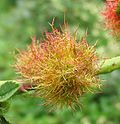Gall




A gall is a growth on the surface of plants and other lifeforms. They are caused by various parasites, such as fungi, bacteria, insects and mites.
Plant galls are abnormal growths of plant tissues similar to benign tumors or warts in animals.[1]
What causes a plant gall can often be known without the actual agent being there. Many types of gall have typical structures. This is true of many galls produced by insects and mites.
Insect galls on plants give some herbivorous insects their own microhabitat. They are plant tissue which is controlled by the insect. Galls are the habitat and food source for the maker of the gall. The gall may contain nutritious starch and other tissues.[2] Galls often give the insect physical protection from predators.[3][4]
Insect galls are usually induced by chemicals injected by the larvae or the adults of the insects into the plants. After the galls are formed, the larvae develop inside until fully grown, when they leave. In order to form galls, the insects must seize the time when plant cell division occurs quickly. The growing season, spring in temperate climates, is longer in the tropics.
Human use
Galls can be used by humans, and have been since ancient times. One use is to collect the pigment which many galls make. The galls are rich in resins and tannins, from which dyes and inks can be made. Galls can be used to make a mordant for dyeing: mordants make the dye on the cloth permanent. Also, permanent black ink can be made from galls, and that has been done for a long time.[5]
The larvae inside the galls may be used as food or as fishing bait, and some galls have medicinal uses.[6]
Gall Media
Cola-nut galls (Andricus lignicola) on pedunculate oak, caused by a cynipid gall wasp
Oak artichoke gall caused by Andricus foecundatrix
Knopper gall caused by Andricus quercuscalicis
Marble gall of oak caused by Andricus kollari
Cherry oak gall caused by Cynips quercusfolii
Red-pea gall (Cynips divisa) on pedunculate oak
References
- ↑ [1] Merriam-Webster Online Dictionary, accessed Nov. 16, 2007 ("an abnormal outgrowth of plant tissue usually due to insect or mite parasites or fungi and sometimes forming an important source of tannin")
- ↑ Larson K.C. and T.G. Whitham 1991. Manipulation of food resources by a gall-forming aphid: the physiology of sink-source interactions. Oecologia 88, 15–21.
- ↑ Weis A.E. and A. Kapelinski 1994. Variable selection on Eurosta’s gall size, II: a path analysis of the ecological factors behind selection. Evolution 48, 734–745.
- ↑ Stone, Graham N. and Schonrogge, Karsten 2003. The adaptive significance of insect gall morphology. Trends in Ecology and Evolution 18(10): 512-522. .
- ↑ Goitein, Shelomo Dov; Sanders, Paula (1967). A Mediterranean Society: Daily life. University of California Press. p. 405. ISBN 0520048695. Retrieved 22 June 2020.
- ↑ Zhang J; Li L; Kim S.H; Hagerman A.E, Lü J. 2009. Anti-cancer, anti-diabetic and other pharmacologic and biological activities of penta-galloyl-glucose. Pharmaceutical Research 26(9): 2066–2080. .
Gallery
Rose bedeguar gall on a wild rose in summer.
Leaf galls on Rhododendron ferrugineum














